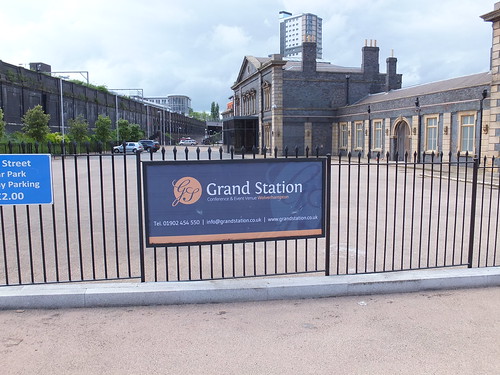 The restored Queen's Building, built 1849, formed the original gateway to Wolverhampton High Level railway station. It was designed by Edward Banks.
The restored Queen's Building, built 1849, formed the original gateway to Wolverhampton High Level railway station. It was designed by Edward Banks.
The southern approach to High Level from Portobello Junction on the Grand Junction Line involved a twisting, tightly-curved route.
In the diesel era, I had offices overlooking this approach and I remember one day when a driver attempted to re-start a long train of loaded 'HAA' hopper wagons destined for Ironbridge Power Station from a signal check on the tight curve. I'm afraid that, rather than follow the curve, the train 'straightened itself out' and most of the wagons tipped over on their sides.The Stour Valley line through Dudley Port diverged from the Portobello route at Crane Street Junction, curving in the opposite direction to exit Wolverhampton on a viaduct.
The through station was built on the straight, although the southern end of the platforms had to curve to reach Crane Street Junction. There were three platforms - Down (Platform 1), Up Main (Platform 2) and Up Loop (Platform 3). Platform 1 had a short bay platform at the Crane Street end, usually referred to as Platform 1 Bay. There was a 'Middle Siding' in between the roads serving platforms 1 and 2 accesible from either end generally used for 'parking' spare vehicles or locomotives. Platform 1 also had a short bay at the north end which stabled vans for sundries traffic.
The approach to Wolverhampton High Level from the north was difficult too - curved and also with a sharp gradient rising into the station. There was a group of carriage sidings on the Up side just north of the station, with a carriage shed a little further north. These sidings provided stock for originating London trains.
Near the end of the steam era, London trains were often hauled by 'Princess Coronation' class locomotives. One frosty, winter morning I remember the driver of a grubby 'Pacific' struggling for about fifteen minutes to move his rake of coaches from the carriage sidings into platform 3, watched by his cold, waiting passengers.

Click on the image above for a larger view
1903 Railway Clearing House diagram of the lines around Wolverhampton.
The station area was controlled by four manual signalboxes, all of London & North Western Railway (L&NWR) style and numbered 1 to 4 from the south, as was L&NWR practice. For signalling diagrams, refer to book reference [5] (below).
I only ever visited Number 1 box, which controlled Crane Street Junction. This box seemed to be called 'Crane Street' by railwaymen as often as 'Wolverhampton Number 1'. Standard L&NWR block instruments communicated with the adjacent boxes at Heath Town Junction on the original line from Portobello Junction, Monmore Green on the Stour Valley Line and, just 227 yards away, Wolverhampton Number 2. Running signals were upper quadrant, using various types of signal post. It was a cramped location and, at either end of the box, additional glazed lights were fitted in the gable end above the standard windows. This was a feature provided to assist signalmen in observing signals at locations where signals close to the box would be otherwise difficult to see. Unusually for this type of signal box, the lever frame was along the rear wall of the box, away from the track. Perhaps this was to improve the signalman's view of the curving layout of tracks?
When 25 kV a.c. electrification was decided upon for Britain's railways, it was High Level Station that was retained and the former Great Western Low Level Station that was abandoned. Whilst the refurbished Low Level Station Building remains as 'Grand Station Conference and Event Venue', very little of the High Level station from the steam era remains.
 Left: Original retaining wall supporting the remaining station, Right: Low Level Station Building is now 'Grand Station'.
Left: Original retaining wall supporting the remaining station, Right: Low Level Station Building is now 'Grand Station'.
Books
[1] ‘Rail Centres: Wolverhampton’ by Paul Collins (originally published in 1990 by Ian Allen, reprinted by Booklaw Publications in 2008) ISBN 1-901945-23-5.Related posts on this site
[2] ‘Wolverhampton Railway Album Volume 1’ by Simon Dewey & Ned Williams (Uralia Press) ISBN 0 9500533 2 5.
[3] ‘Wolverhampton Railway Album Volume 2’ by Simon Dewey & Ned Williams (Uralia Press) ISBN 0 9500533 3 3.
[4] ‘Wolverhampton to Stafford’ by Vic Mitchell (Middleton press) ISBN: 978 1 908174 79 6.
[5] ‘British Railways Layout Plans of the 1950’s - Volume 11: LNW Lines in the West Midlands’ (Signalling Record Society) ISBN: 1 873228 13 9.
West Midland Railways.
9:17 a.m. to Birmingham.
More on Wolverhampton High Level.
My pictures
West Midland Railways.
